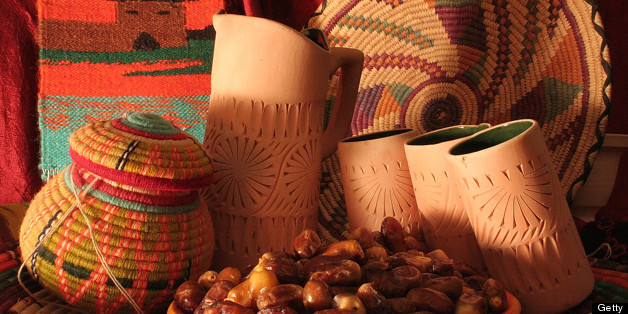
For more than 10 years food blogger Yvonne Maffei has been fasting but the last two years Ramadan has fallen in weather that was significantly warmer than in previous years and days when the fast was much longer. That means extra preparation and knowing what to eat during non-fasting hours is essential to good health and endurance during the entire month.
During my teaching years I remember listening to community members and school kids with stories about how they’d wanted to change the foods they ate in Ramadan in order to feel healthier, which is one of the reasons I began working on solutions by providing healthy recipes and cooking tips.
A fasting person needs good, nutrient-rich food that provides the energy necessary for the priorities of daily life and no other time of year is that more important than during Ramadan when we’re fasting for long hours, some of us in very hot climates or in the summer season.
Here are my top tips for eating healthy during that short time of day in the month of Ramadan when food and drink are meant to be consumed.
Eat Real Food, Not Processed and Junk Foods
Sure, processed foods can seem convenient, but they’re usually filled with unhealthy things like high-fructose corn syrup, MSG (to enhance flavor), lots of sodium and typically all the wrong heart-clogging oils. If you’re in a hurry, there are healthy and halal-convenient options that are particularly good for breaking the fast, so get to know the halal food businesses that make and serve them (see my top picks at the end of this article).
Junk foods like chips, candies, and more are basically void of nutrients and should not be used as a side dish (believe me, I’ve seen it before). How will you have any energy to get you through a long day of fasting and long night of prayer if your food gives you nothing in return for eating it? Instead, shop for locally produced fruits and veggies from farmers markets and grocery stores, which are now following the trend of sourcing ingredients from local vendors. Because of a higher demand for such goods, the prices are finally coming down somewhat. Furthermore, when you eat food that is wholesome and packed with nutrition, you’ll feel more satisfied. In fact, you may even find yourself needing to eat less of it than filler foods that hardly satisfy the stomach and make you crave more and more of them.
Avoid “White” Foods
White foods (i.e., white bread, white rice, white sugar, etc.) can fall into some of the above categories, but they’re worth the mention for what not to eat. White breads are made from white flour, which is processed and stripped of the nutrition that should be in bread and the same goes for rice and even the type of sugar you use. Instead, choose breads from whole grains and organic brown rice (even basmati). Surprisingly, they don’t have to break the bank, either, since much of this is available in bulk at quality grocers like Whole Foods.
Know the Foods That Hydrate Your Body
When fasting, we’re slowly being dehydrated over the course of the day, so once we break our fast and during the non-fasting period we need to have foods that put water into our body, not deplete it further. It can be difficult to eat a lot of watermelon or squash, even though they’re super-hydrating foods, but you can make juices out of the fruits and soups out of the vegetables to give your body the additional water it needs. Avoid salty spice mixes and condiments that sneak their way into our rice and meat dishes only to leave us wondering why we’re so thirsty afterwards. A great way to break the fast is to enjoy your favorite dates, of course, but also consider having coconut water, or making smoothies, coolers and fruity drinks which are super-hydrating. They can be consumed at the Suhoor (pre-dawn meal before the fasting day begins) or at the Iftar (meal at the time of breaking the fast) followed by soup to preface your main meal. Consider limiting coffee and tea which are very dehydrating to the body, to about half of what you normally drink.
Avoid Fried & Sugary Foods
In an effort not to spoil any cultural traditions in Ramadan foods, I’m not advocating that everyone forgo their favorite samosas or empanadas at I12ftar. I love them, too! But, I do know that it’s possible to bake them instead of fry, so consider that an option. Fried foods are heavy in oil and that makes them harder to digest, especially when they’re the first foods to be eaten after a long fast.
Let’s save the sweets for ‘Eid ul Fitr (the celebration that comes after the month of fasting) and try to hold off on as many desserts as possible to avoid any sugar crashes later in the day. If you must have something sweet, make it natural — use real honey or natural raw cane sugar (turbinado) in your recipes, or eat fruits that are a bit more on the sweet side to satisfy the craving… naturally.
Go Easy on the Carbs
While I love a good bowl of pasta, a hefty portion of potatoes or rice with meat, these are all carbohydrates to minimize during Ramadan. Carbohydrates are converted into sugars and can eventually take their toll on your body way after you’ve finished eating. When you do have your carbohydrates, be sure to pair them with protein-rich foods like beans, meat or eggs to balance the meal.
May everyone who observes the blessed month of Ramadan have a peaceful, healthy and happy time with family, friends and community.
Disclaimer: the purpose of this article is not intended as medical advice. The author nor the website are not responsible for any side effects or harm from following its contents. Please consult with your physician regarding fasting or consuming any particular foods before doing so.
